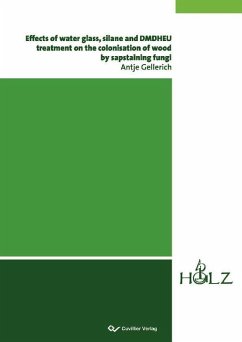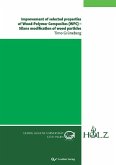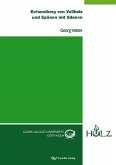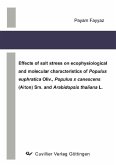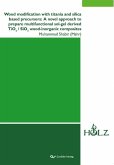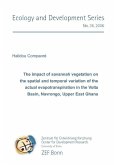The objective of this study was the investigation of the resistance of modified
wood against sapstaining fungi and the investigation of the influences of fungal
growth. Specimens of Scots pine sapwood (Pinus sylvestris L.) and Beech wood
(Fagus sylvatica L.) were investigated after being treated with an amino-alkylfunctional
oligomeric siloxane, a sodium water glass solution and 1,3-dimethylol-
4,5-dihydroxyethylene urea (DMDHEU).
The following is a structured outline of this study:
Laboratory tests for the resistance against the blue stain fungus
Aureobasidium pullulans
The objective was to develop a laboratory test method against blue stain for
modified wood as well as the determination of the resistance against blue stain.
After definition of a suitable test method, the laboratory tests displayed an
improved resistance against blue stain for all tested modified wood specimens.
Regardless of the wood species, the fungal infestation was reduced but not
inhibited. Among the treated specimens, the water glass treated specimens
showed the lowest, the siloxane treated specimens the highest infestation
respectively.
Field tests for the determination of the resistance against sapstaining fungi
The fungal infestation was investigated during outside exposure of the
specimens. The infestation of the modified specimens was decelerated. The
specimens were infested mainly by ascomycetes and deuteromycetes which are
ubiquitary. The fungal composition displayed only marginal differences
compared to untreated wood. The most dominant fungi which were detected were
Trichoderma sp. and Epicoccum sp. irrespective of wood species and
modification type.
Investigation of the influence factors of fungal development
Wood moisture content: The results displayed a reduced equilibrium moisture
content (EMC) for DMDHEU treated wood compared to the untreated controls.
The water glass treatment caused an increase of EMC, which was in the range of
the untreated controls after a leaching procedure. The siloxane treatment did not
cause significant changes in EMC compared to untreated controls.
Available simple sugars: A reduction of fungal growth caused by a reduced
amount of available simple sugars and their composition was detected for water
glass treated specimens only.
Lignin degradation: The lignin degradation during outside exposure,
investigated by FTIR-spectroscopy, did not show a reduction in modified wood
specimens, regardless of wood species and modification type.
Penetration of fungal hyphae: Macroscopic and microscopic investigations
revealed a reduced radial penetration of fungal hyphae in DMDHEU treated
wood. A siloxane and water glass treatment inhibited the radial penetration into
the wood tissue. In this case, fungal growth was visible on the specimen surface
only.
Summarising, the results revealed that the influences of fungal growth were
dependent on the type of modification and independent of the wood species. The
reduction of fungal infestation on water glass treated specimens was mainly
influenced by the pronounced alkaline pH-value and a reduced content of free
available simple sugars. The fungal growth on DMDHEU and siloxane treated
wood was largely influenced by changes in wood moisture content.
Dieser Download kann aus rechtlichen Gründen nur mit Rechnungsadresse in A, B, BG, CY, CZ, D, DK, EW, E, FIN, F, GR, HR, H, IRL, I, LT, L, LR, M, NL, PL, P, R, S, SLO, SK ausgeliefert werden.

